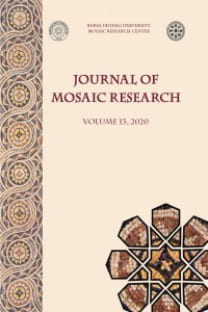Mozaikler Aracılığıyla Ostia Antica’da Dindarlığın Bazı Yönleri
Mitoloji, Ostia Antica’nın mozaiklerinde (hem zeminde olanlar hem de olmayanlar) en yaygın temalardan biri iken, bazı kompozisyonlar dini ve kült ile ilgili bakış açısından belirgin bir öneme sahiptir. Bu çalışmada Ostia kültlerinin mozaik temsillerinin incelenmesi amaçlanmakta olup; bunlar arasında Mithras kültü yayılımı ve tanıklıklarının çokluğu açısından özel bir şekilde öne çıkmaktadır. Mozaik, kuşkusuz, içeriğinin anında görsel olarak iletilmesi amacını taşıyordu, çünkü Mithras dini, her şeyden önce, görüntüler aracılığıyla iletişimin daha uygun olduğu alt kademe inananlar tarafından kabul edilmişti. Bununla birlikte, Ostia’da kültün takipçileri arasında, yüksek rütbeli şahsiyetlerin, hatta belki de imparatorluk ailesinden kimselerin de olduğuna dair kanıtlar bulunmaktadır. Mithras’ın yanında Sabazio kültü de vurgulanacak olup, geçmişteki diğer doğu tanrılarının izleri kimi zaman doğru kimi zaman yanlış biçimde de olsa Dioscures Evi’nde, Balıklar Evi’nde, Neptün Hamamları’nda ve Deniz Kapısı’nın opus sectile binasında (İS 4. yy) bulunmuştur
Anahtar Kelimeler:
Mithralar, doğu kültleri, Ostia, dindarlık, senkretizm
Some Aspects of Religiosity in Ostia Antica Through Mosaics
While mythology is one of the most widespread themes in the mosaics of Ostia Antica (both floor and non-floor), some compositions have a marked importance from a religious and cultic point of view. We intend to examine the mosaic representations of aspects of the Ostian cults, among which that of Mithras stands out in a particular way for its diffusion and for the amplitude of its testimonies. The mosaic undoubtedly had the purpose of immediate visual communication of its contents, also because the religion of Mithras was accepted above all by low-level believers for whom communication through images was more suitable. However, in Ostia, among the followers of the cult, there is evidence of high-ranking personages, perhaps even belonging to the imperial family. Next to that of Mithras we want to highlight the cult of Sabazio, of other oriental divinities in the past traces have been found, sometimes rightly and sometimes wrongly, in the House of the Dioscures, in the House of the Fishes, in the Neptune’s baths and in the opus sectile building of the Marine Gate (4th century AD).
Keywords:
Mithrei, oriental cults, Ostia, religiosity, syncretism,
___
- Battisti 2021 M. Battisti,“Mithras sodalis: mitrei in edifici collegiali ostiensi”, F. Fontana - E. Murgia (eds.), Sacrum facere, Atti del VI Seminario di Archeologia del Sacro, Forme associative e pratiche rituali nel mondo antico, Trieste, 303-320.
- Becatti 1954 G. Becatti, Scavi di Ostia, II, I Mitrei, Roma.
- Becatti 1961 G. Becatti, Scavi di Ostia, IV, Mosaici e pavimenti marmorei, Roma.
- Beck 1979 R. Beck, “Sette sfere, sette porte and the spring equinoxes of A.D. 172 and 173”, U. Bianchi (ed.), Mysteria Mithrae, Leiden, 515-529.
- Bloch 1953 H. Bloch, “Iscrizioni rinvenute tra il 1930 e il 1939”, NSc 7, 239-305.
- Bouke van der Meer 2012 L. Bouke van der Meer, Ostia speaks, Inscriptions, buildings and spaces in Rome’s main port, Leuven.
- Brenk 2001 B. Brenk, “La christianisation d’Ostie”, J. P. Descoeudres (ed.), Ostie, Port et Porte de la Rome antique (exh. cat.), Genève, 262-271.
- Calza 1940 G. Calza, La necropoli del Porto di Roma nell’Isola Sacra, Roma.
- Clarke 1979 J. R. Clarke, Roman Black-and-White Figural Mosaics, New York.
- Coarelli 1989 F. Coarelli, “Apuleio ad Ostia?”, DialA 7, 27-42.
- D’Asdia 2002 M. D’Asdia, “Nuove riflessioni sulla domus di Apuleio a Ostia”, ArchCl 53, 433-464.
- Dunbabin 1999 K. M. D. Dunbabin, Mosaics of the Greek and Roman World, Cambridge.
- Floriani Squarciapino 1962 M. Floriani Squarciapino, I culti orientali ad Ostia, Leiden.
- Gabriele 2021 M. Gabriele, I sette talismani dell’impero, Milano.
- Gasperini 1988 L. Gasperini, “Dedica ostiense di Aurelio Aviano Simmaco all’imperatore Costante”, Misc. Gr. Rom. 13, 242-250.
- Hänninen 2019 M.-L. Hänninen, “Mithran Kultti Ostiassa”, A. Karivieri - M. Meriluoto (eds.), Ostia Portti Roomaan (exh. cat.), Helsinki, 319-325.
- Homann-Wedeking 1942 E. Homann-Wedeking, “Archäologische Grabungen und Funde in Italien, Albanien und Libyen, Oktober 1941 bis Oktober 1942”, AA 57, 277-389.
- Jenssen Tveit 2007 L. Jenssen Tveit, Mosaikkinskrifter i Romersk Privatarkitektur, Oslo.
- Licordari 2019 A. Licordari, “Alcune iscrizioni sacre ostiensi”, ArchCl 70, 733-745.
- Licordari - Pellegrino 2022 A. Licordari – A. Pellegrino, “Il tema mitologico nei mosaici di Ostia”, C. Angelelli - M. Emilio Erba - D. Massara - E. Zulini (eds.), Atti del XXVII Colloquio AISCOM, Roma, 285-300.
- Mazzucato 2021 N. Mazzucato, “Il Cristo filosofo della domus di Porta Marina: un approccio teologico”, C. Angelelli - C. Cecalupo (eds.), Atti del XXVI Colloquio AISCOM, Roma, 577-586.
- Meiggs 1977 R. Meiggs, Roman Ostia, Oxford.
- Merkelbach 1998 R. Merkelbach, Mitra, Il signore delle grotte, Genova.
- Paschetto 1912 L. Paschetto, Ostia colonia romana, Roma.
- Pavolini 2006 C. Pavolini, Ostia, Bari.
- Pellegrino 1988 A. Pellegrino, “Note sul culto di Serapide ad Ostia”, Misc. Gr. Rom. 13, 225-41.
- Pellegrino 2017 A. Pellegrino, Mosaici e pavimenti di Ostia, Monte Compatri.
- Pietrangeli 1943 C. Pietrangeli, “Un mosaico inedito di palazzo Altieri con il mito di Marte e Rea Silvia”, L’Urbe VIII 1-2, 2-5.
- Quack 2013 J. F. Quack, “Serapis als neuer Gefährte der Isis”, C. Hattler (ed.), Imperium der Götter, Darmstadt, 164-170.
- Van Haeperen 2019 F. Van Haeperen, Fana, templa, delubra. Regio I, Ostie, Porto, Roma.
- Van Haeperen 2021 F. Van Haeperen, “The mithraea of Ostia and their worshippers”, L. Bricault - R. Veymiers - N. Amoroso (eds.), The Mystery of Mithras, Mariemont, 349-356.
- Vermaseren 1956-1960 M. J. Vermaseren, Corpus Inscriptionum et Monumentorum Religionis Mithriacae, Den Haag.
- ISSN: 1309-047X
- Başlangıç: 2008
- Yayıncı: Ululdağ Üniversitesi, Mozaik Araştırlmaları Merkezi
Sayıdaki Diğer Makaleler
Mozaikler Aracılığıyla Ostia Antica’da Dindarlığın Bazı Yönleri
Antonio LICORDARI, Francesca LICORDARI, Angelo PELLEGRINO
Agnese FRANZONI, Elena SAGRIPANTI, Paola PERPIGNANI, Michele MACCHIAROLA, Simone ZAMBRUNO
Sırrı ÇÖLMEKÇİ, Emrah KAHRAMAN, Emir SON
Paola PERPIGNANI, Paolo RACAGNI
Hadrianopolis Kiliseleri Zemin Mozaiklerindeki Haç ve Haçvari Motifler
Rhodiapolis Piskoposluk Kilisesi Mozaikleri
Altın Sarısı ve Mavi Geҫişi - Tarihi Bir Yerde Çağdaş Bir Gerçekleşme
Tryphe ve Bios Mozaiği’nin İkonografik ve İkonolojik Açıdan Değerlendirilmesi
